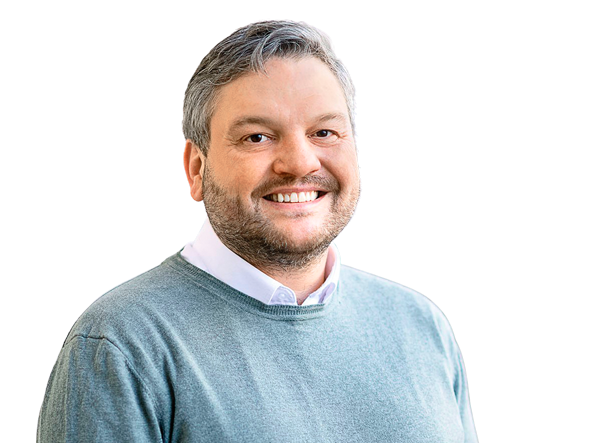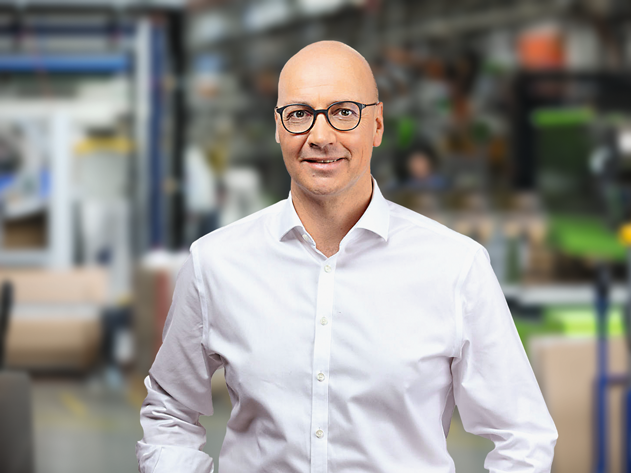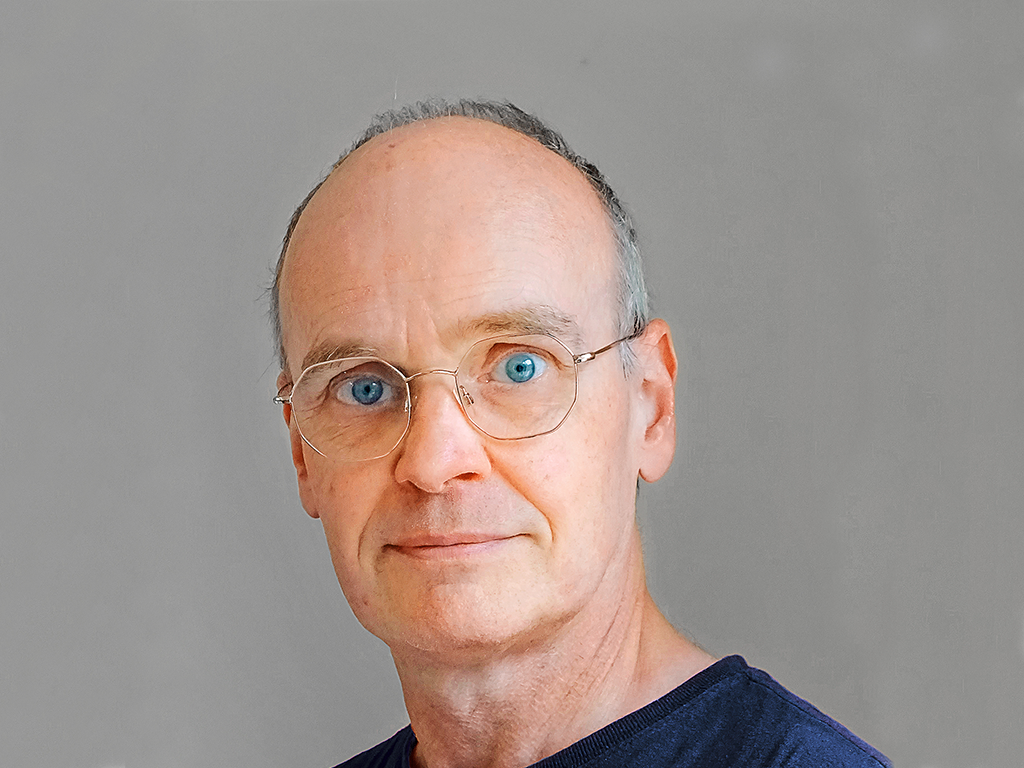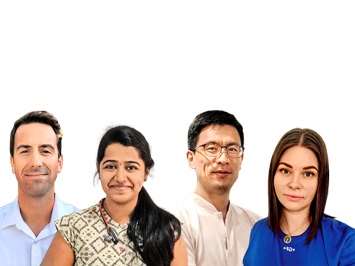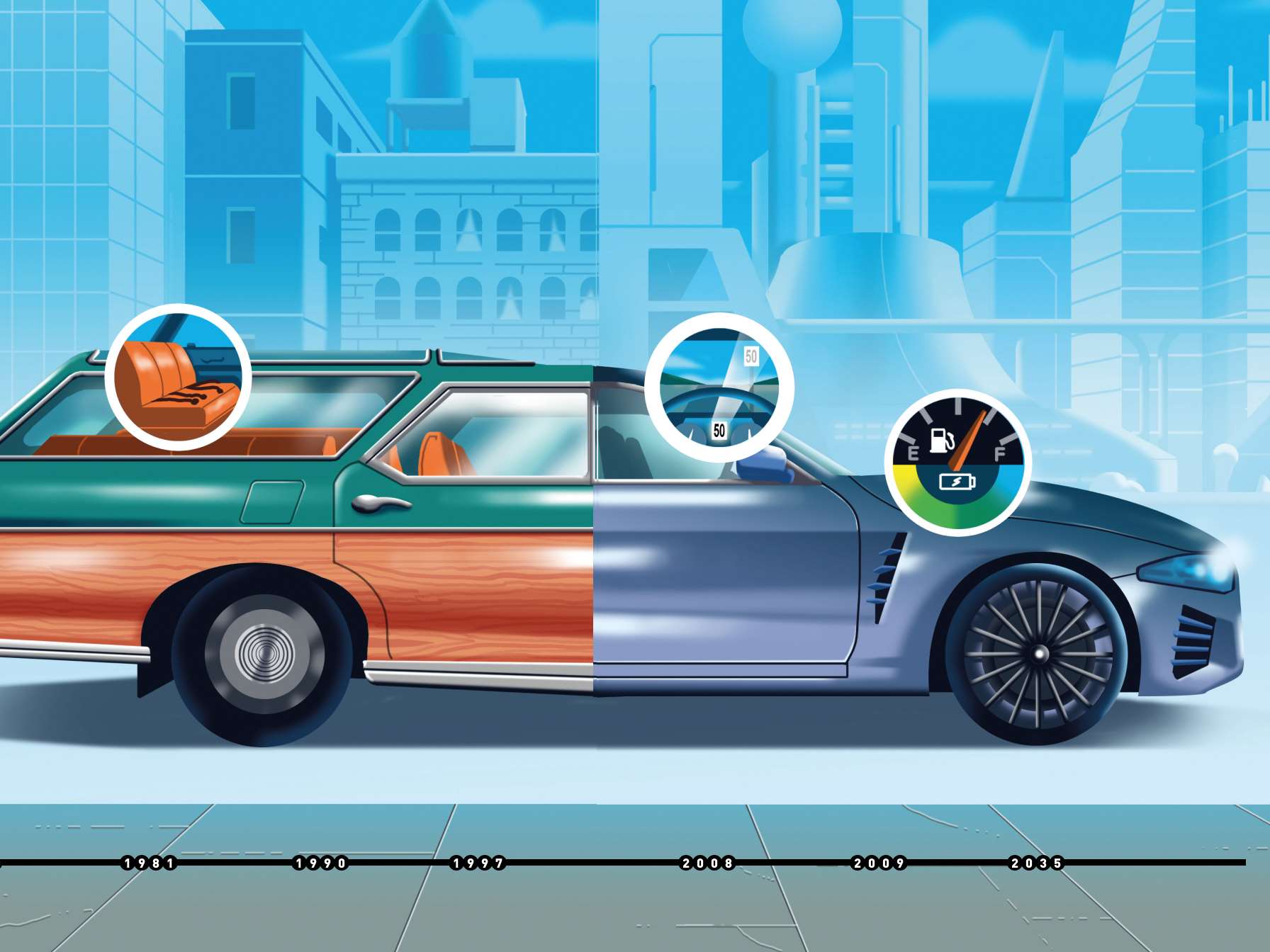Sabine Tunzini and Gabriel Selbach work at GF Casting Solutions finding sustainable solutions for the future. GF approaches sustainable mobility with a holistic view, looking beyond just the value chain.
Sustainable mobility
Today, we can only guess how we will be getting from A to B in the future. Self-driving vehicles, hyperloops, fully connected cars – who knows? But one thing is clear: The mobility of tomorrow will be sustainable. Innovative ideas from bright minds show how GF is integrating sustainability across the entire value chain and beyond.
Filmmakers of the mid-1980s sometimes offered these crazy fantasies of people talking to their cars via their wristwatches or of riding a hoverboard to get around town. Nearly 40 years down the road, these imaginative ideas have become reality. And experts are now predicting that in another 30 years vehicles will be able to travel autonomously both on land and in the air (see interview). Or maybe even Tesla boss Elon Musk’s dream of his Hyperloop will have come true. This concept sees people riding in capsules, or “pods,” through a vacuum tube.
Ambitious objectives
Ideas for new concepts of mobility often originate in the desire to further develop autonomous driving in terms of more comfort, or to connect vehicles to improve safety and the flow of traffic, so, not always for reasons of sustainability. But the sustainability aspect cannot be ignored. After all, according to the United Nations (UN), the transport sector is responsible for around one-quarter of global greenhouse gas emissions. For this reason, the transport sector needs to reduce its greenhouse gas emissions quickly and drastically in order to counteract global warming. The GF Strategy 2025 includes a set of targets for developing innovative solutions and products that follow an environmentally friendly life cycle and strengthen the future of sustainable mobility.
“We will continue to increase the precision of the simulations in the future so we can produce the components more easily while consuming less energy.”
Dominik Mahnig, Head of Product Development at GF Casting Solutions
 © Martin Maier
© Martin Maier“The challenge will be to keep climate protection and the social aspects of sustainability in mind along the entire value chain while developing these vehicles of the future,” says Christina Widmann, Sustainability Manager at GF Casting Solutions. This value chain includes the procurement of materials and machinery, as well as managerial tasks such as establishing sustainable thinking as part of a culture of innovation. Sales and logistics are as much a part of the value chain as the use of the product and end-of-life management – that is, what happens to the product when it is no longer needed. GF considers aspects of sustainability in all these areas.
 © Martin Maier
© Martin MaierStarting off with innovative ideas
Things always start with an idea for a new product. GF has “reorganized its innovation management for this focus on sustainability, among other things,” explains Sabine Tunzini, Innovation Manager at GF Casting Solutions.
It is generally employees who provide the inspiration for these ideas. A system is in place to continuously evaluate them in terms of sustainability right from the outset. In addition, GF is receptive to new ideas from outside the company as part of its collaboration with Startup Autobahn, an open innovation platform that brings together technology start-ups and leading industrial companies to jointly develop innovations.
Computer-aided design and virtual simulation have revolutionized the design process in the automotive industry. In addition to cutting costs and saving time, virtual simulations essentially mean that fewer resources are consumed, because significantly fewer prototypes are required. At GF, this affects a significant number of all components produced, including body & structure, powertrain and chassis parts for the automotive industry. “We would like to continue greatly increasing the precision of simulations in the future, so we can produce the components even more easily while consuming less energy,” says Dominik Mahnig, Head of Product Development at GF Casting Solutions.
Sustainable products and materials
In addition, GF Casting Solutions uses the principle of bionic topology optimization when developing innovative products. In this process, computer-aided geometries are created that are based on shapes found in nature. After all, nature has had millions of years to learn how to be efficient, economical and resilient at the same time. “Lightweight design and sustainability in automotive engineering are the be-all and end-all of development,” Dominik says. Lightweight design contributes to increasing the range of electric vehicles while also reducing carbon emissions. When developing lightweight components, the challenge is to continue to meet the high load requirements placed on a vehicle while it is in operation.
GF is leading the way with its commitment to preliminary and series development. “We design, simulate, optimize and validate everything from a single source with our strong capacities for research and development. It helps us to provide optimum support to the customer,” Dominik says. And the focus always remains on developments pertaining to products, processes and materials. In the past, GF has been able to leverage this innovation and development process to bring products to the market that have enabled weight savings of up to 40%.
 © Martin Maier
© Martin Maier © Martin Maier
© Martin MaierResources and the circular economy
Right from the beginning of development, attention is paid to keeping the company’s own resources in the cycle for as long as possible along the entire value chain. After all, there is no waste in nature. In this manner, GF wants to reach the next level of the circular economy. According to the Strategy 2025, 70% of sales in 2025 are to be generated from products and solutions with social or environmental benefits for our customers.
GF focuses on reusing materials many times over, as well as on selecting materials that can be returned to the manufacturing cycle. The GF Casting Solutions foundries are an example of this. The division now uses more than 90% recycled materials in iron casting. In addition, it is working towards further increasing the content of recycled materials in aluminum alloys. For example, scrap companies supply recycled materials such as auto body & structure scrap, sheet metal scrap from heating appliances or tire wires for iron casting. Leading vehicle manufacturers attach great importance to the carbon footprint and appreciate the longstanding transparency that GF has always exemplified.
For Gabriel Selbach, Head of Innovation at GF Casting Solutions, the company is using innovation as a means to assume more leadership in terms of sustainability: “We strengthen our competitiveness and the future orientation of our products on the market by focusing on sustainability.”
Extracting lithium from wastewater
GF Piping Systems is also working together with customers on innovative recycling solutions for sustainable mobility. Battery technology based on lithium is driving the “electric” revolution on the road, so to speak. The demand for this light metal has greatly increased. However, the way in which it is currently mined is not very environmentally friendly.
Saltworks Technologies, a Canadian company, provides an alternative to conventional methods for lithium extraction. This process involves industrial wastewater being subjected to reverse osmosis. The byproduct of the filtration process is a caustic solution from which Saltworks can then extract lithium for batteries by means of ion exchange. Nina Pongracz is Global Communications Manager for Sustainability at GF Piping Systems and offers this explanation: “The brine is thick, salty, bad for the environment, and it is difficult to dispose of completely.”
But thanks to products from GF, this byproduct can now be used as a raw material. GF Piping Systems ensures that the plant operates efficiently using process automation that includes valves, fittings and pipes. The quality of the GF products here is a unique selling point. The GF brand is also considered by leading industrial customers to stand for the safe disposal of residual material, as well as a higher yield of clean water. “One leading microelectronics company insisted on GF products being used in order to ensure accuracy and quality,” says Nina.
 © Martin Maier
© Martin Maier © Stefan Meyer/Meyerkangangi
© Stefan Meyer/MeyerkangangiLithium from wastewater
Together with Saltworks, GF Piping Systems is working to improve the sustainability of battery production by extracting lithium from wastewater. But how does it work? Antoine Walter, Senior Business Development Manager for Wastewater Treatment at GF Piping Systems, speaks to Saltworks co-founder and CEO Benjamin Sparrow in the podcast “(Don’t) Waste Water.”
Click here to access the (don’t) Waste Water podcast.
Production challenges
The pressure to make transportation more sustainable is creating challenges in manufacturing – for example, when it comes to components for the aviation and aerospace industries. “Lighter weight materials can reduce fuel usage and emissions in the air, just as they do on the ground,” explains Dameon Crane, Sales Manager Europe at GF Machining Solutions. In this area, GF primarily produces machines for manufacturing parts used in engines and aircraft cabins. For example, lightweight composites for aircraft fuselages can reduce kerosene consumption by up to 20% and by around 15% for engines with high bypass ratios.
“Lighter weight materials can reduce fuel and emissions in the air, just as they do on the ground.”
Dameon Crane, Sales Manager Europe at GF Machining Solutions
 © Stefan Meyer/Meyerkangangi
© Stefan Meyer/Meyerkangangi © Stefan Meyer/Meyerkangangi
© Stefan Meyer/MeyerkangangiHowever, a higher bypass ratio also means that more air flows out of the turbine, thus increasing the engine efficiency, which generates significantly more heat and affects the compressor in the process.
This applies, for example, to the bladed disks, or blisks, used as a component of the engine compressor. These are a combination of rotor disks and blades and ensure that a sufficient quantity of compressed air enters the engine. Engine manufacturers have started to use Inconel, a special nickel-chromium alloy, instead of the materials commonly used to make engines, such as aluminum or titanium, in order to withstand the extra heat. Ceramics are being used to replace the metal components in turbines. However, the new material is creating challenges in production. “It only takes a few minutes to make metal components. But it can take hours to make the same component from a new material,” Dameon explains.
Today, the six furnaces are operating with greater efficiency than manufacturer specifications at the site in Herzogenburg (Austria), which greatly reduces the demand for natural gas. “We want to move away from fossil fuels in the future and start using more renewable energy sources, such as electricity for induction furnaces,” reports Michael Kornherr, Head of Smelting at GF Casting Solutions in Herzogenburg. Transmission housings, such as ones for hybrid electric vehicles, battery housings, doors and rear door frames for vehicles are produced in this town near Vienna. Artificial intelligence (AI) helps find the optimal settings for the production parameters more quickly, for example, when working with new products. This also helps keep scrap at a minimum.
Making internal processes more sustainable
GF takes a holistic view of sustainable mobility, which means that internal processes are also constantly optimized. The in-out-in system from GF Machining Solutions is one example of how the company is doing this. The system eliminates single-use packaging for GF products; they are now delivered in heat-stabilized, lightweight packaging for transport. Greenhouse gases can also be eliminated when customers no longer need to use loader cranes for the products. The in-out-in system has been responsible for producing 42% less CO2 during transport.
Since the start of 2023, there has been an electric truck at GF Casting Solutions, instead of a conventional truck, regularly traveling between the Altenmarkt and Herzogenburg sites. It transports everything needed in production, from tools to components. The electric truck can save around 75 metric tons of CO2 per year compared to the use of vehicles that run on fossil fuels.
In addition, electric-powered forklifts have been replacing conventional diesel-powered ones at many sites. The fleet vehicles for field representatives will also be gradually converted to electric vehicles over the next few years. There are electric bikes at some sites for employee use. Charging stations are gradually being installed.
Environmentally friendly every step of the way
It is crucial for the mobility of the future that environmentally friendly, efficient products be developed, while paying attention to the choice of raw materials and sustainable production methods. But sustainability does not stop when the product leaves the warehouse. For this reason, GF is also working on improving sustainability in logistics by using lighter weight packaging and making powertrains more environmentally friendly (see sidebar).
But what happens to a product when it is no longer needed? It is crucial also to have a well-designed recycling concept. For example, several functions in a Mercedes S-Class model have been combined in a single- piece cross member for the cockpit developed and manufactured by GF, which results in greater recyclability.
“We don’t throw away anything.”
Michael Kornherr, Head of Smelting at GF Casting Solutions
Environmental protection is also a priority in production in the GF Casting Solutions foundry where Michael works – likewise, for the sprues, a type of net in the form of a cluster from which the components are detached. The “branches” can then be recycled without further issues. “We don’t throw away anything anymore,” says Michael. A product’s carbon footprint is determined by the sum of all measures. It is important to consider the eco balance over the product’s entire life cycle. This is the only way in which sustainable products for the mobility of the future can be produced in a genuinely sustainable manner. And this applies to all modes of transportation, both the ones we use currently and those we still consider to be science fiction.
Further impressions:
Read the other Spotlight articles here:
Powering new mobility
GF is one of the players with the know-how to help shape the sustainable mobility of tomorrow, says CEO Andreas Müller.
A world of pods and robots
How will we move around in 30 years and what technologies will we be using? We interview renowned British futurist Dr. Ian Pearson, who discusses developments and offers his prospects for the future.
How important is sustainability to you?
Sustainable living is growing in importance. But how can we do it best? Four GF employees from different regions tell us how they live sustainability in their daily lives and what it is they value.
Sustainable metamorphosis
How does a modern car compare to one from the 1970s?
Our facts and figures show this.





